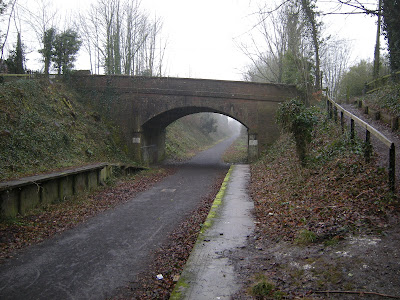

Track preparation and tracklaying westwards from Bodiam - another thing they told us we'd never see! (Courtesy
Rother Valley website)

Bodiam station (18.4.1976), before regular services reached the station. It was amazing the way this bit of the KESR retained its Colonel Stephens atmosphere.
An excellent post to the
message board - yet more trackbed is turning into a railway again. This is on the 'lost' section of the
Kent and East Sussex Railway, the section westwards from Bodiam to the network junction at Robertsbridge.
The KESR was the jewel in the crown of the
Colonel Stephens railway empire, which included lines like the
East Kent Railway, the
Selsey Tramway, the
Shropshire and Montgomeryshire Railway and, closer to home, the
Weston, Clevedon and Portishead Railway.It opened in 1900 and closed to passengers in 1954. Freight traffic remained on the Robertsbridge-Tenterden section until 1961. A preservation society was quickly set up and the track remained in place. Tenterden is a reasonably sized town so does really require a railway.
Right from the start there was typical 1960s opposition to the line returning, most of which hinged on the railway's numerous ungated level crossings but mainly on the level crossing of the A21 trunk road at Robertsbridge. After court battles the KESR finally won the right to survive, but did have to abandon the link with the network. Over the years the line has gradually extended westwards in stages, and now reaches the honeypot of Bodiam with its castle.
But many supporters of the route never gave up on the 21st century idea of linking the line back to the network and at last the first bit of tracklaying has now happened on the section westwards from Bodiam. This part of the route is being restored by the separate
Rother Valley Railway.Even the most blinkered petrolhead will concede that in the future any heritage railway that wants to survive in an energy-poor future will need to offer both real train services and a link to the main rail network. I'll even forecast that some time in the next 20 to 30 years the KESR will look again to restoring the genuinely lost section of its route, the section northwards to Headcorn and a main commuter route into London, and beyond that to build the sections planned but never constructed, to Rye and Maidstone.
The light railway was an idea ahead of its time. Cheap oil killed many of them off, the end of cheap oil will signal a huge increase in light railway construction. They may not have the dubious 'charm' of the originals, but they will do what light railways were conceived for, providing cheap and modern transport to rural areas.








































